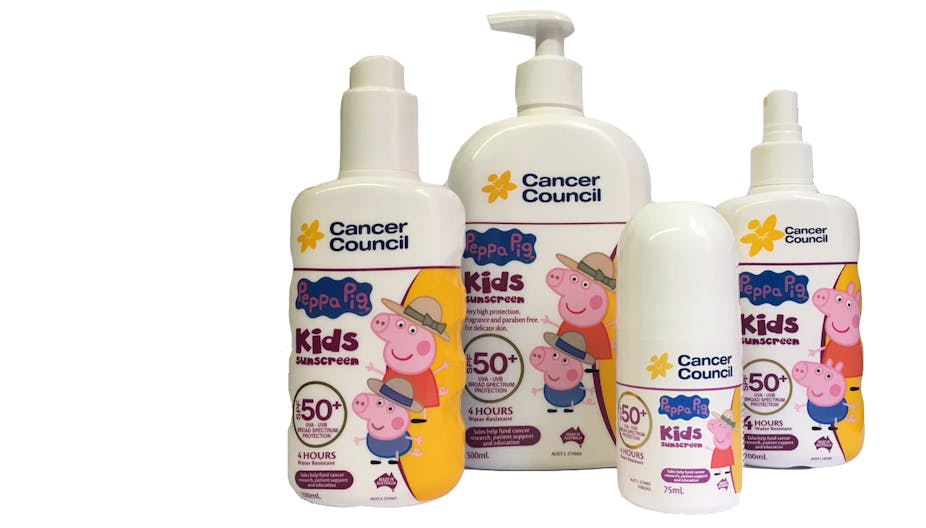The Peppa Pig brand of sunscreens are manufactured on behalf of the Cancer Council Australia. While they have been available for some time, some parents have recently reported their use has resulted in severe burn-like symptoms on their own, and their children’s, skin. As such, there has been a concerted call on social media to have the products removed from sale.
Despite these reports, the listed ingredients used in the sunscreens are approved by the government and used in a number of different sunscreen brands. While we cannot be sure why there have been a small number of reported reactions in people, it is more likely a general sensitivity reaction rather than the body’s response to a specific ingredient.
If parents are concerned about this particular brand of sunscreen, they should speak to their pharmacist about alternatives they can use for their children.
Ingredients in the sunscreen
The Peppa Pig sunscreen products are approved as “listed medicines”, which are low risk products compared with registered medicines, such as those available on prescription or from behind the counter at pharmacies. They are given a number by the Therapeutic Goods Administration (TGA) to show they are an approved listed medicine; in this case AUST L 236490, 274965, and 274967.
In Australia, listed medicines can only use pre-approved, lower risk ingredients that have been assessed by the TGA for safety and quality. As such, side-effects due to their use should be rare.
Although there appears to be four different Peppa Pig sunscreens, they are all nearly identical products that only significantly differ in their packaging.
The sunscreens contain four active ingredients: 4-methylbenzylidene camphor, octyl triazone, butyl methoxydibenzoylmethane, and octocrylene. These chemicals are added to sunscreens because they can either reflect Ultraviolet A (UVA) and Ultraviolet B (UVB) sunlight away from the skin, or because they can absorb the light before it can damage the skin.
The Peppa Pig sunscreens also contain the same chemical preservative, octanohydroxamic acid. Preservatives are used to prevent the growth of bacteria and mould in the formulations.
While all these chemicals have scary sounding chemical names, all are common ingredients that are used in many different brands of sunscreens, not just the Peppa Pig brand. In addition, all the active ingredients are specifically approved by the TGA.
Potential skin reactions
Without access to the medical records of those affected, it is very difficult to conclude what the problem may be. Even though the Peppa Pig sunscreen products are listed medicines, it does not mean they are risk free. People using the sunscreens can still experience negative reactions, because they carry the same risks as most other sunscreens.
The Australian Medicines Handbook states adverse effects to sunscreens are rare; it is expected fewer than 0.1% of users will experience a reaction.
Common skin reactions to the active ingredients of sunscreens include pain, redness, itching, inflammation, blisters, and thick, leathery, or scaly skin.
Considering the Cancer Council claims to have sold hundreds of thousands of Peppa Pig products, the number of reported adverse reactions is within the expected range given by the Australian Medicines Handbook.
However, adverse events due to a specific ingredient cannot be ruled out since photoallergic reactions to all four active ingredients have been reported in the scientific literature.
Photoallergic reactions occur due to exposure of the sunscreen ingredients to ultraviolet light. This changes the ingredients to chemicals that get attacked by the immune system, that then results in symptoms like itchy skin, redness, and lesions.
For example, this report describes a sunscreen containing 4-methylbenzylidene camphor, among other active ingredients, causing a photoallergic reaction in an elderly man.
In more complete studies of sunscreens with butylmethoxydibenzoylmethane, one study of 2715 patients resulted in an adverse event rate of 0.1%. In a smaller study of 69 patients, a higher percentage of patients (4.3%) reported a reaction to butylmethoxydibenzoylmethane containing sunscreens.
While it is possible the reactions could have been due to a “bad batch” of the sunscreens if they were somehow contaminated with other, unlisted ingredients, this has been ruled out by the Cancer Council as they report they conducted tests on the batch and random samples from retail stores.
What should worried parents do?
For those who have used the sunscreen in the past, and not experienced side-effects, you can continue to do so as it remains on sale.
For those trying it for the first time, parents should perform a small patch test, especially if their child has sensitive skin. The test can be performed by applying some sunscreen on a small area of skin on the inner forearm and monitoring for any changes to the condition of the skin.
If your child has an allergic reaction to any sunscreen, Sunsmart Australia recommends trying sunscreens with different ingredients or a fragrance free product. Toddler or sensitive sunscreen formulations may suit those with sensitive skin. In particular, parents may consider sunscreens containing only zinc and titanium oxide as they are less likely to cause photoallergic reactions. Otherwise, your pharmacist can also offer advice when choosing a sunscreen product.
Most importantly, reports of sensitivities to particular brands of sunscreen should not deter you from ensuring that your child is adequately protected from the sun.
Yu Qing Elysia Ong, Bachelor of Pharmacy student, co-authored this article.

